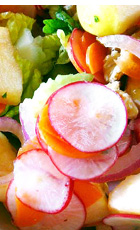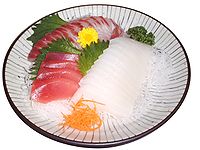Raw foodism


Raw foodism,also known asrawismor araw food diet,is thedietary practiceof eating only or mostly food that isuncookedandunprocessed.Depending on the philosophy, or type of lifestyle and results desired, raw food diets may include a selection of fruits, vegetables, nuts, seeds, eggs, fish, meat, and dairy products. The diet may also include simply processed foods, such as various types ofsprouted seeds,cheese, andfermentedfoods such asyogurts,kefir,kombucha,orsauerkraut,but generally not foods that have beenpasteurized,homogenized,or produced with the use of syntheticpesticides,fertilizers,solvents,andfood additives.
TheBritish Dietetic Associationhas described raw foodism as afad diet.[1]Raw food diets, specifically raw veganism, may diminish intake of essential minerals and nutrients, such asvitamin B12.[1][2][3]Claims made by raw food proponents arepseudoscientific.[4]: 44
Varieties
[edit]Raw food diets are diets composed entirely or mostly of food that is uncooked or that is cooked at low temperatures.[2][3][5]
Raw animal food diets
[edit]
Raw animal food diets include any animal that can be eaten raw, such as uncooked, unprocessed raw muscle-meats/organ-meats/eggs, raw dairy, and aged, raw animal foods such ascentury eggs,fermentedmeat/fish/shellfish/kefir,as well as vegetables, fruits, nuts, and sprouts, but in generalnotraw grains, raw beans, and raw soy. Raw foods included on such diets have not been heated above 40 °C (104 °F).[3][6]"Raw Animal Foodists" believe that foods cooked above this temperature have lost much of their nutritional value and are harmful to the body.Smokedmeats are frowned upon by many Raw-Omnivores.[7]Some make a distinction between hot-smoked and cold-smoked.
Diet examples
[edit]- The "People's Primal Potluck",[8][9]anopsology (otherwise known as "instinctive eating" ), and the "Raw Paleolithic Diet"[10][11](otherwise known as the "raw meat diet" ).[12]
- The "primal diet" consists of fatty meats, organ meats, dairy, honey, minimal fruit and vegetable juices, and coconut products, all raw.[13][14]
- The "raw Paleolithic diet",[11][15]is a raw version of the (cooked)Palaeolithic diet,incorporating large amounts of raw animal foods such as meats/organ-meats, seafood, eggs, and some raw plant-foods, but usually avoiding non-Paleo foods such as raw dairy, grains, and legumes.[11][12]
The founder of the Primal Diet isAajonus Vonderplanitz,a resident of Malibu, California. It has been estimated by Aajonus Vonderplanitz that there are 20,000 followers of his raw-meat-heavy Primal Diet in North America, alone.[13]
- Aboriginaldiets consisted of large quantities of raw meats, organ meats, and berries, including the traditional diet of theNenetstribe of Siberia,[16]and theInuit.[17][18][19]
- Pemmicanis the traditional North American travel food, prepared from dried meat, fat, and berries.[20]
-
Kefirpreparation
-
Asashimidinner set
-
Rawhorse meatset
Raw veganism
[edit]
Raw veganism has rarely been practised in history,[21]but it became a fad in the 21st century.[22]A raw vegan diet consists of unprocessed, raw plant foods that have not been heated above 40–49°C(104–120°F). Typical foods included in raw food diets are fruits, vegetables, nuts, seeds, and sprouted grains and legumes.
Among raw vegans are subgroups, such as"fruitarians","juicearians", or "sproutarians". Fruitarians eat primarily or exclusively fruits, berries, seeds, and nuts. Juicearians process their raw plant foods into juice.[23]
TheBritish Dietetic Associationnamed the raw vegan diet one of the "top 5 worst celeb diets to avoid in 2018", raising a concern that it could compromise long-term health.[24]
History
[edit]Early documentation of raw food dieting has been associated withhermitsandmonkspractisingasceticism.For example,John of Egypt,a hermit from theNitrian Desertin the 4th Century, reportedly lived on a diet of dried fruit and vegetables for fifty years; he never ate anything cooked.[25]Documented evidence of a commitment to raw food was by the EthiopianmonkQozmos, who in the late 1300s CE committed to the ascetic discipline of eating only uncooked food.[26][27]This posed a problem for hisEthiopian Orthodox Tewahedo Churchmonasterybecause he refused to eat the bread of theEucharist,which is cooked. As a result, he fled the church and went to live with the Jewish community of theBeta Israel.[26][27]
Contemporary raw food diets were first developed in Switzerland byMaximilian Bircher-Benner(1867–1939), who was influenced as a young man by the GermanLebensreformmovement, which saw civilization as corrupt and sought to go "back to nature"; it embracedholistic medicine,nudism,free love,regular exercise and other outdoors activity, and foods that it judged were more "natural".[4]: 41–43 Bircher-Benner eventually adopted avegetariandiet, but took that further and decided that raw food was what humans were really meant to eat; he was influenced byCharles Darwin's ideas that humans were just another kind of animal and Bircher-Benner noted that other animals do not cook their food.[4]: 41–43 In 1904 he opened a sanatorium in the mountains outside of Zurich called "Lebendinge Kraft" or "Vital Force", a technical term in the Lebensreform movement that referred especially to sunlight; he and others believed that thisenergywas more "concentrated" in plants than in meat, and was diminished by cooking.[4]: 41–43 Patients in the clinic were fed raw foods, includingmuesli,which was created there.[4]: 41–43 These ideas were influential toAnn Wigmore,a notable raw food advocate, but were dismissed by scientists and the medical profession as quackery.[4]: 41–43
One of the earliest books to advocate raw foodism wasEugene Christian'sUncooked Foods and How to Use Them,1904.[28]Other proponents from the early part of the twentieth century include Californian fruit growerOtto Carque(author ofThe Foundation of All Reform,1904),George Julius Drews(author ofUnfired Food and Trophotherapy,1912),Bernarr MacfaddenandHerbert Shelton.Drews influencedJohn and Vera Richterto open America's first raw food restaurant "The Eutropheon" in 1917.[28]
Shelton was arrested, jailed, and fined numerous times for practising medicine without a license during his career as an advocate of rawism and other alternative health and diet philosophies. Shelton's legacy, as popularized by books likeFit for Lifeby Harvey andMarilyn Diamond,has been deemed "pseudonutrition" by the National Council Against Health Fraud.[29]
In the 1970s,Norman W. Walker(inventor of the Norwalk Juicing Press) popularized raw food dieting.[30]Leslie Kenton's bookRaw Energy – Eat Your Way to Radiant Health,published in 1984, added popularity to foods such as sprouts, seeds, and fresh vegetable juices.[31]The book advocates a diet of 75% raw food, which it claims will preventdegenerative diseases,slow the effects of aging, provide enhanced energy, and boost emotional balance; it cites examples such as the sprouted-seed-enriched diets of the long-livedHunza peopleandGerson therapy,an unhealthy, dangerous and potentially very harmful[32][33]raw juice-based diet and detoxification regime claimed to treat cancer.[32]
In the 21st century, raw food diets (particularly those focused onraw milk,raw eggs and raw meat) have been popularized and politicized as part of a broader "right-wingbodybuilder "movement centered aroundhypermasculinity,physical fitness, fascination with ancient civilizations and opposition tofeminismand mainstream modern culture.[34]
Claims
[edit]Claims held by raw food proponents include:
- That heating food above 104–118 °F (40–48 °C) degradesenzymesin raw food that aid digestion. In fact, enzymes in food play no significant role in the digestive process, prior to being digested themselves.[3]
- That raw foods have highernutrientvalues than foods that have been cooked.[4]: 44 In fact, cooking has widely variable results on nutritional content, depending on the plant source and cooking method, and may actually increase availability of fat-based nutrients, such asvitamin Eandbeta-carotene.[3][35][36]
- That foods cooked at high temperatures, especially meat, may contain harmful toxins, includingtrans fatty acidsproduced by heating oil,acrylamideproduced by frying,advanced glycation end products(AGEs), andpolycyclic aromatic hydrocarbons.[37]Not all cooked food contains harmful chemicals, and a diet containing a mix of cooked and raw food is normal.[37][38]According to theAmerican Cancer Society,it is not clear as of 2019[update]whether acrylamide consumption affects the risk of cancer.[39]Public health authorities recommend reducing consumption of overly-cooked starchy foods or meats.[37][39][40]
Health effects
[edit]
A raw food diet is likely to impair the development of children and infants.[41]Care is required in planning a raw vegan diet, especially for children,[42]as there may not be enough vitamin B12,vitamin D,and calories for a growing child on a totally raw vegan diet.[43]
Food poisoningis a health risk for all people eating raw foods, and increased demand for raw foods is associated with greater incidence offoodborne illness,[44]especially for raw meat, fish, and shellfish.[45][46]Outbreaks ofgastroenteritisamong consumers of raw and undercooked animal products (including smoked, pickled or dried animal products[45]) are well-documented, and include raw meat,[45][47][48]raw organ meat,[47]raw fish (whether ocean-going or freshwater),[45][46][48]shellfish,[49]raw milk and products made from raw milk,[50][51][52]and raw eggs.[53]
One review stated that "Many raw foods are toxic and only become safe after they have been cooked. Some raw foods containsubstances that affect the absorption of nutrients,interfere with digestive enzymes or damage the walls of the intestine. Raw meat can be contaminated withbacteriawhich would be destroyed by cooking; raw fish can contain substances that interfere with vitamin B1 (anti-thiaminases) "[54]
See also
[edit]- Amílcar de Sousa,20th century raw foodist
- Béla Bicsérdy
- Bernando LaPallo
- Cooking
- Fruitarianism
- Green smoothie
- List of diets
- Orthopathy
- Category:Raw foodists
- Rejuvelac
- Sattvic diet
- Taboo food and drink
- Xerophagy,a form of fasting
- Liver King,an internet influencer known for eating raw meat and organs
- Raw water
References
[edit]- ^ab"Fad diets".British Dietetic Association.Retrieved3 August2023.
- ^abKoebnick, Corinna; Garcia, Ada Lizbeth; Dagnelie, Pieter C.; Strassner, Carola; Lindemans, Jan; Katz, Norbert; Leitzmann, Claus; Hoffmann, Ingrid (2005)."Long-Term Consumption of a Raw Food Diet Is Associated with Favorable Serum LDL Cholesterol and Triglycerides but Also with Elevated Plasma Homocysteine and Low Serum HDL Cholesterol in Humans".The Journal of Nutrition.135(10): 2372–2378.doi:10.1093/jn/135.10.2372.ISSN0022-3166.PMID16177198.
- ^abcdeWanjek, Christopher(16 January 2013)."Reality Check: 5 Risks of a Raw Vegan Diet".Scientific American.
- ^abcdefgFitzgerald, Matt (2014).Diet Cults: The Surprising Fallacy at the Core of Nutrition Fads and a Guide to Healthy Eating for the Rest of US.Pegasus Books.ISBN978-1-60598-560-2.
- ^Kaufman CF (2013)."Cooking Techniques".In Smith AF, Kraig B (eds.).The Oxford Encyclopedia of Food and Drink in America.Vol. 1 (2nd ed.). Oxford University Press. pp. 537–544.ISBN978-0-19-973496-2.
- ^"Primal Dieting: Eat Your Raw food With A Roar!".Foodenquirer.com.Archivedfrom the original on 23 March 2012.Retrieved31 January2012.
- ^"Model of health: as a supermodel, Carol Alt says she was often run-down. Then she switched to a raw diet and regained her energy".Natural Health.2008.
- ^Green, Emily (31 January 2001)."Meat but No Heat – Los Angeles Times".Articles.latimes.com.Archivedfrom the original on 27 August 2011.Retrieved12 May2010.
- ^"Vue Weekly: Edmonton's 100% Independent Weekly: Well met, raw meat: hoorah for raw!".Vueweekly.com.Retrieved10 April2015.
- ^"Raw Paleo Diet – The Raw Paleolithic Diet & Lifestyle!".Rawpaleodiet.com.Archivedfrom the original on 30 October 2008.Retrieved7 November2008.
- ^abc"Raw Paleo Diet – RVAF Systems Overview".Archivedfrom the original on 17 July 2012.
- ^abMore for less (12 June 2005)."The raw meat diet: do you have the stomach for the latest celebrity food fad? – Health News, Health & Wellbeing – The Independent".London: Independent.co.uk.Archivedfrom the original on 5 December 2008.Retrieved7 November2008.
- ^abMeat: A Love StoryArchived14 September 2008 at theWayback Machine
- ^"Vue Weekly: Edmonton's 100% Independent Weekly: Well met, raw meat: Hoorah for raw!".Archived fromthe originalon 13 September 2008.Retrieved14 September2008.
- ^"Raw Paleo Diet – The Raw Paleolithic Diet & Lifestyle!".Rawpaleodiet.com.Archivedfrom the original on 30 October 2008.Retrieved7 November2008.
- ^Viestad, Andreas (14 May 2008)."Where Home Cooking Gets the Cold Shoulder".The Washington Post.Retrieved22 May2010.
- ^Viestad, Andreas (14 May 2008)."Where Home Cooking Gets the Cold Shoulder".Washingtonpost.com.Archivedfrom the original on 6 November 2012.Retrieved7 November2008.
- ^"In pictures: Cooking in the Danger Zone, Rotten walrus meat".BBC News.Archivedfrom the original on 12 January 2009.Retrieved7 November2008.
- ^Sinclair, H. M. (1953)."The Diet of Canadian Indians and Eskimos".Proceedings of the Nutrition Society.12:69–82.doi:10.1079/PNS19530016.S2CID71578987.
- ^"Gardening: Serviceberry is staple of springtime"The Spokesman Review.Retrieved 8 May 2018.
- ^Fontana, Luigi; Shew, Jennifer L.; Holloszy, John O.; Villareal, Dennis T. (28 March 2005). "Low Bone Mass in Subjects on a Long-term Raw Vegetarian Diet".Archives of Internal Medicine.165(6): 684–9.doi:10.1001/archinte.165.6.684.ISSN0003-9926.PMID15795346.
- ^Kamiński, Mikołaj; Skonieczna-Żydecka, Karolina; Nowak, Jan Krzysztof; Stachowska, Ewa (12 February 2020)."Global and local diet popularity rankings, their secular trends and seasonal variation in Google Trends data".Nutrition.79–80: 110759.doi:10.1016/j.nut.2020.110759.ISSN0899-9007.PMID32563767.S2CID213610247.
- ^NTP, Ayla Freitas."Raw Foodism and Vegan Subgroups".www.afpafitness.com.Retrieved3 December2022.
- ^"Top 5 worst celeb diets to avoid in 2018".British Dietetic Association. 7 December 2017.Archivedfrom the original on 31 July 2020.
- ^Bangley, Bernard. (2005).Butler's Lives of the Saints: Concise, Modernized Edition.Paraclete Press. p. 67.ISBN978-1557254221
- ^abBinns, John (28 November 2016).The Orthodox Church of Ethiopia: A History.I.B.Tauris. p. 30.ISBN9781786720375.
- ^abKaplan, Steven. "Qozmos." Encyclopaedia Aethiopica: O-X: Vol. 4, edited by Siegbert Uhlig, Harrassowitz, 2010, p. 303.
- ^abBerry, Rynn. (2007). "Raw Foodism". In Andrew F. Smith.The Oxford Companion to American Food and Drink.Oxford University Press.pp. 493–494.ISBN978-0-19-530796-2
- ^Jarvis, PhD, William T."Fasting".National Council Against Health Fraud.Retrieved8 April2014.
- ^Coull, Lauren. (2015). "Raw Food". In Andrew F. Smith.Savoring Gotham: A Food Lover's Companion to New York City.Oxford University Press. pp. 490–491.ISBN978-0-19-045465-4
- ^"Raw energy".New Insight. Archived fromthe originalon 25 October 2003.Retrieved7 November2008.
- ^ab"Gerson Therapy".American Cancer Society.Archived fromthe originalon 20 April 2009.Retrieved22 April2009.
- ^UK, Cancer Research (1 December 2015)."Gerson therapy".Archivedfrom the original on 7 January 2016.
- ^"Unpacking the weird alt-right propaganda behind the raw meat movement".Dazed Digital.14 March 2022.
- ^Palermo, M; Pellegrini, N; Fogliano, V (April 2014). "Review: The effect of cooking on the phytochemical content of vegetables".Journal of the Science of Food and Agriculture.94(6): 1057–70.doi:10.1002/jsfa.6478.PMID24227349.
- ^Lee, Seongeung; Choi, Youngmin; Jeong, Heon Sang; Lee, Junsoo; Sung, Jeehye (12 December 2017)."Effect of different cooking methods on the content of vitamins and true retention in selected vegetables".Food Science and Biotechnology.27(2): 333–342.doi:10.1007/s10068-017-0281-1.ISSN1226-7708.PMC6049644.PMID30263756.
- ^abc"Chemicals in meat cooked at high temperatures and cancer risk".US National Cancer Institute. 11 July 2017.Retrieved1 November2020.
- ^Scientific Committee on Food – Task Force on PAH (4 December 2002)."PAH – Occurrence in foods, dietary exposure and health effects"(PDF).European Commission.Archived(PDF)from the original on 21 March 2017.Retrieved12 May2014.
- ^ab"Acrylamide".American Cancer Society.11 January 2019. Archived fromthe originalon 20 November 2016.Retrieved1 September2014.
- ^"Food Controversies—Acrylamide".Cancer Research UK. 2016.Retrieved23 January2017.
- ^Cunningham, E (2004). "What is a raw foods diet and are there any risks or benefits associated with it?".Journal of the American Dietetic Association.104(10): 1623.doi:10.1016/j.jada.2004.08.016.PMID15389429.
- ^Messina, V; Mangels, AR (2001). "Considerations in planning vegan diets: children".Journal of the American Dietetic Association.101(6): 661–9.doi:10.1016/S0002-8223(01)00167-5.PMID11424545.
- ^Rachel Breitman."The raw food diet: a half-baked idea for kids? — JSCMS".Jscms.jrn.columbia.edu. Archived fromthe originalon 10 May 2008.Retrieved7 November2008.
- ^Lee, CC; Lam, MS (1996). "Foodborne diseases".Singapore Medical Journal.37(2): 197–204.PMID8942264.
- ^abcdMacpherson, CN (2005). "Human behaviour and the epidemiology of parasitic zoonoses".International Journal for Parasitology.35(11–12): 1319–31.doi:10.1016/j.ijpara.2005.06.004.PMID16102769.
- ^abLun, ZR; Gasser, RB; Lai, DH; Li, AX; Zhu, XQ; Yu, XB; Fang, YY (2005). "Clonorchiasis: a key foodborne zoonosis in China".The Lancet Infectious Diseases.5(1): 31–41.doi:10.1016/S1473-3099(04)01252-6.PMID15620559.
- ^abYoshida, H; Matsuo, M; Miyoshi, T; Uchino, K; Nakaguchi, H; Fukumoto, T; Teranaka, Y; Tanaka, T (2007)."An outbreak of cryptosporidiosis suspected to be related to contaminated food, October 2006, Sakai City, Japan".Japanese Journal of Infectious Diseases.60(6): 405–7.PMID18032847.Archived fromthe originalon 14 February 2012.Retrieved8 February2014.
- ^abPozio, E (2003). "Foodborne and waterborne parasites".Acta Microbiologica Polonica.52 Suppl: 83–96.PMID15058817.
- ^Su, YC; Liu, C (2007). "Vibrio parahaemolyticus: a concern of seafood safety".Food Microbiology.24(6): 549–58.doi:10.1016/j.fm.2007.01.005.PMID17418305.
- ^Centers for Disease Control and Prevention (CDC) (2008)."Escherichia coli 0157:H7 infections in children associated with raw milk and raw colostrum from cows—California, 2006".MMWR. Morbidity and Mortality Weekly Report.57(23): 625–8.PMID18551097.Archivedfrom the original on 15 June 2017.
- ^Donnelly, Catherine W. (1990)."Concerns of Microbial Pathogens in Association with Dairy Foods".Journal of Dairy Science.73(6): 1656–61.doi:10.3168/jds.S0022-0302(90)78838-8.PMID2200814.
- ^Doyle, MP (1991). "Escherichia coli O157:H7 and its significance in foods".International Journal of Food Microbiology.12(4): 289–301.doi:10.1016/0168-1605(91)90143-D.PMID1854598.
- ^Cox, JM (1995). "Salmonella enteritidis: the egg and I".Australian Veterinary Journal.72(3): 108–15.doi:10.1111/j.1751-0813.1995.tb15022.x.PMID7611983.
- ^Bender, Arnold E. (1986).Health or Hoax?: The Truth About Health Foods and Diets.Sphere Books. p. 40.ISBN0-7221-1557-1





